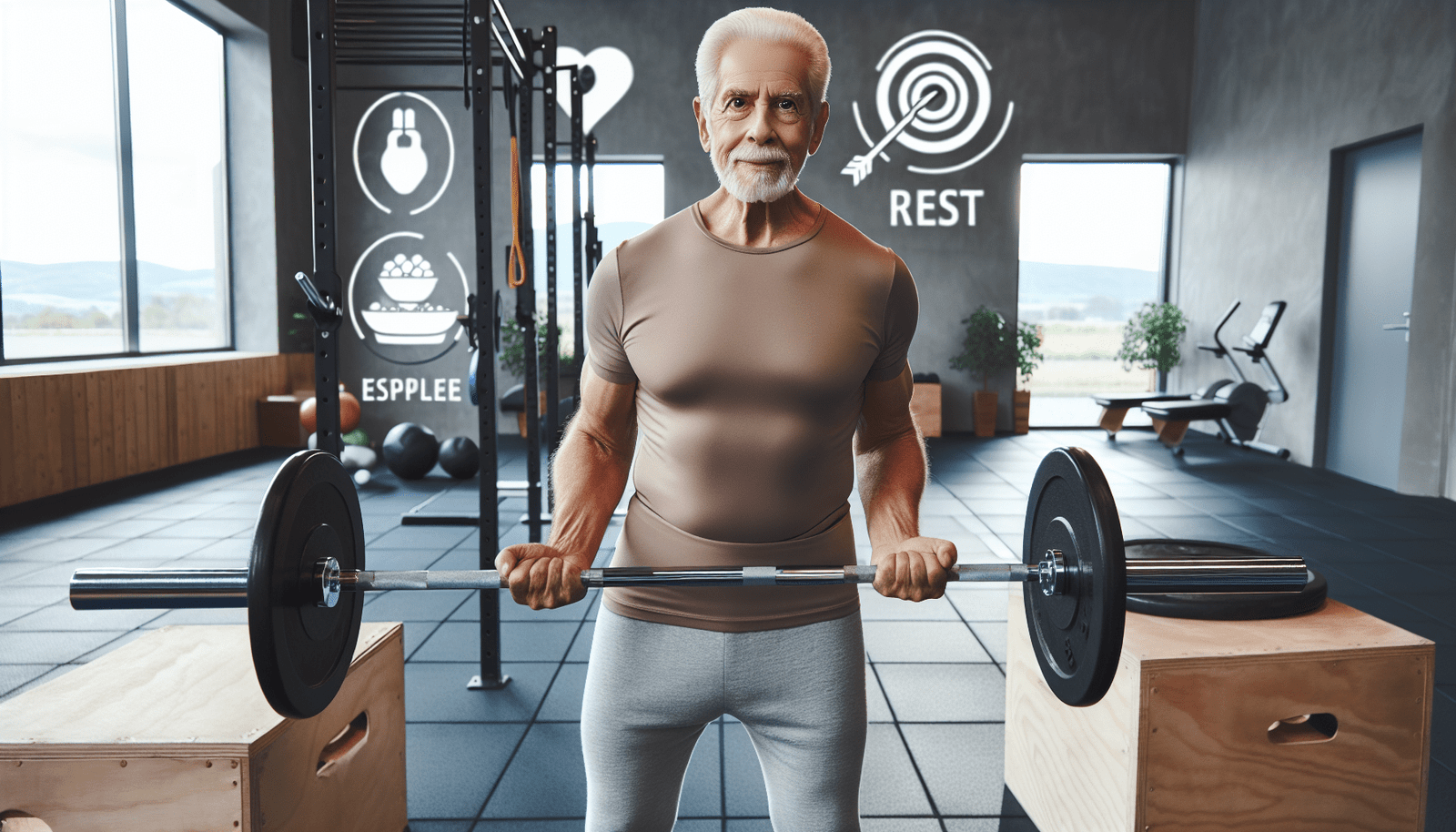Mastering the Art: How to Build Muscle After 60
It may surprise you, but your body isn’t tied to the whims of a ticking clock. No matter if your sixtieth birthday has come and gone, you can still craft a muscular, strong physique—it might even be easier than you think! “Mastering the Art: How to Build Muscle After 60” is the guide to show you exactly how. The article will break down all the basics, answering all your burning questions about building muscle in your golden years and offering science-backed tips and strategies for achieving your fitness goals. Prepare to redefine the way you think about aging – strength, vitality, and muscle growth aren’t just for the young, they’re yours for the taking too!

Understanding Why Muscle Growth Becomes Challenging After 60
In the journey to remain fit and healthy, there’s no doubting that age becomes a significant variable. As we age, several physiological changes take place, many of which impact muscle growth. Increasingly, these changes can make muscle growth more challenging as you enter your 60s and beyond.
Learning about muscular changes over time
As we grow older, our bodies undergo significant changes, especially regarding our muscles. Muscle cells begin to reduce in number and size and can be replaced by fat cells. A decrease in the synthesis of muscle proteins also contributes to this process. These factors eventually lead to decreases in strength, endurance, and functionality, changing how our bodies operate and how easily we could build muscle.
Understanding the role of age in muscular atrophy
Age plays a significant role in these muscle changes. Variations are most evident when it comes to the rates of muscular atrophy, which is basically the wasting away of muscles. As we age, this process naturally accelerates, impacting both muscle mass and strength. Sedentariness due to age can exacerbate this process, making active engagement in muscle-strengthening exercises crucial for maintaining optimal muscle health.
Importance of addressing sarcopenia
Sarcopenia, or the loss of muscle mass, is a common condition that affects many people as they age. Although it can appear in anyone, it is more prevalent among those over the age of 60. Addressing sarcopenia through physical activity and proper nutrition can significantly improve your chances of maintaining or even increasing your muscle mass, enhancing your quality of life.
Safety Considerations for Seniors Looking to Build Muscle
Before you embark on your journey to muscle growth, it is essential to prioritize safety and ensure that the exercises and activities you engage in are suitable for your age, health status, and physical condition.
Medical clearance and physical exams
Before starting any exercise program, always obtain medical clearance from your healthcare provider. They can evaluate your health status, determine your readiness for physical activity, and guide you on the appropriate exercises.
Importance of professional support and supervision
Having professional support and supervision during your exercise sessions is crucial, especially if you’re new to fitness or have existing health conditions. Trainers and physical therapists can help you execute movements correctly and safely, minimizing the risk of injury.
Warning signs to watch out for
Watch out for signs of undue strain or discomfort. If you experience unusual tiredness, chest pain, dizziness, or shortness of breath during or after your workout, it’s best to consult your healthcare provider immediately.
Risk minimization tactics
To reduce risk, it’s essential to start slow and gradually increase the intensity of your workouts. Always prioritize proper form over weights or repetitions, ensure a balanced workout regimen, warm up before and cool down after exercise, and hydrate adequately throughout your session.
Influencing Factors in Muscle Growth for Seniors
Several factors affect muscle growth in seniors. Here, we discuss some of the most prominent ones:
The role of genetics
Genetics plays a significant part in our ability to build muscle. Some people have a natural disposition to build muscle quickly, while others may find it more challenging.
Importance of diet and nutrition
Proper diet and nutrition are critical to muscle growth. For building and maintaining muscle mass, you need sufficient protein along with a balanced intake of other macronutrients. Diet also plays a direct role in helping you maintain a healthy weight, support your immune system, fuel your workouts, and recover after exercise.
Effects of lifestyle factors
Lifestyle factors like smoking, alcohol consumption, and a sedentary lifestyle can negatively impact muscle growth. Regular exercise, a balanced diet, and avoiding harmful substances can go a long way in promoting healthy muscle development.
Influence of existing health conditions
Existing health conditions such as arthritis, diabetes, heart disease, and obesity can affect your ability to engage in regular physical activity and, consequently, your muscle growth.
Crucial Role of Resistance Training
Resistance training, which involves activities that make your muscles work against a weight or force, is a key part of building muscle.
Basics of resistance training
Resistance training can include exercises that leverage your body weight (like squats, push-ups, and lunges), work with free weights (like dumbbells or kettlebells), utilize resistance bands, or use weight machines.
How resistance training stimulates muscle growth
When resistance training, your muscles experience microscopic damage or tears, which the body repairs during recovery periods. This repair process leads to the growth and strengthening of muscle fibers, contributing significantly to muscle growth.
Safe resistance exercises for seniors
Start with exercises that utilize your own body weight, then gradually introduce light dumbbells or resistance bands into your routine. Always prioritize form, and avoid any movements that cause discomfort or pain. Some senior-friendly resistance exercises include leg presses, bicep curls, knee extensions, and seated rowing exercises.

Cardiovascular Exercise for Over 60s
Cardiovascular exercise plays a dual role in muscle growth for seniors, aiding in overall physical fitness and promoting a healthy body composition.
How cardiovascular exercise aids muscle growth
Cardiovascular exercise, or cardio, improves heart health and increases blood flow to your muscles, which is essential for muscle function and growth. It also aids in calorie burn and fat loss, helping to reveal the muscle you’re working so hard to build.
Safely incorporating cardio into a workout routine
Start with low-impact cardio exercises like brisk walking, cycling, or swimming, increasing intensity and duration gradually. Aim to get at least 150 minutes of moderate-intensity cardio exercise per week, as recommended by health organizations.
Beneficial cardiovascular exercises for seniors
Dependent on your current fitness level, effective cardio exercises for seniors can include brisk walking, swimming, water aerobics, cycling, or even dancing!
Role of Proper Nutrition
The fuel you provide to your body significantly influences muscle growth, especially given our dietary needs change as we age.
Optimal diet for muscle growth
The ideal diet for muscle growth includes a balanced mix of macronutrients: adequate proteins, carbohydrates, and healthy fats. Whole foods like lean meats, dairy products, fruits, vegetables, legumes, whole grains, nuts, seeds, and oily fish can provide these essentials.
Importance of protein consumption
Protein is the building block of muscle. It’s crucial for muscle repair and growth, particularly following exercise. It’s recommended to distribute your protein intake evenly across meals throughout your day and consuming a source of protein after workouts.
Managing dietary needs for seniors
For seniors, nutrient-dense foods are key as they provide the necessary nutrients without excess calories. Additionally, because older adults commonly endeavor a decline in appetite, it’s essential to eat small, frequent meals and focus on including protein at every meal.
Influence of hydration on muscle growth
Adequate hydration is vital for various physiological processes, including muscle growth. Inadequate fluid intake can impair your performance during workouts and slow down muscle recovery, negatively impacting muscle growth.

Supplementation for Muscle Growth
Supplementation can be helpful to enhance muscle growth, but should not replace a balanced diet and should always be used with guidance from a healthcare provider.
Effective supplements for muscle growth
Some supplements that might aid muscle growth include protein powders, branched-chain amino acids (BCAAs), creatine, and omega-3 fatty acids. These can support muscle protein synthesis, provide energy for workouts, and aid in recovery.
Considering safety and risks of supplementation
Supplements should be used safely. Using large amounts or combining supplements can lead to harmful side effects and interactions. Additionally, supplements are not regulated as strictly as medications, so it’s important to choose reputable brands.
Recommended supplements for seniors
While the supplements mentioned above could be beneficial, seniors might also need to consider supplementation for other nutrients like vitamin D, calcium, or magnesium, important for bone health and muscular function.
Consulting a healthcare provider
Before starting any supplement regime, always consult with your healthcare provider or a dietitian. They can provide recommendations based on your health status and nutritional needs.
Rest and Recovery Strategies for Seniors
Just as important as exercise and nutrition, rest and recovery play a crucial role in muscle growth.
Understanding the role of rest and recovery
Rest allows your body time to repair and strengthen itself between workouts. Lack of adequate rest can lead to overtraining, decreased performance, and an increased risk of injuries.
Ensuring adequate sleep for muscle growth
For seniors, quality sleep is essential as it facilitates many of the body’s repair processes, including muscle recovery and growth. Strive to get seven to nine hours of sleep each night.
Mindfulness and relaxation strategies
Practicing mindfulness and relaxation techniques including yoga, meditation, or deep breathing can help manage stress levels, improve sleep quality, and enhance your overall sense of well-being, all of which can contribute positively to your muscle-building journey.

Overcoming Mental Barriers
While physical barriers to building muscle are significant, often the most challenging barriers are mental.
Challenges in motivation and discipline
Motivation and discipline are key to consistency, which is crucial for results. Overcoming these challenges often requires setting clear goals, developing a plan, and finding forms of exercise that you enjoy.
Setting achievable fitness goals
Goal setting can provide motivation, offer direction, and serve as a way to measure progress. Keep your goals SMART: Specific, Measurable, Achievable, Relevant, and Time-bound.
Developing a positive mindset
Maintain a positive mindset and offer yourself compassion and patience. Expect ups and downs on your muscle-building journey, and remember that any progress—no matter how small—is still progress.
Seeking support from communities or groups
Exercising with friends or engaging in a fitness group can offer valuable support and motivation. Fitness communities foster accountability, and they can make workouts more fun and fulfilling, too.
Frequent Questions About Building Muscle After 60
At this point, you may have some questions, and that’s perfectly fine. Here are answers to some frequently asked ones:
Is it safe to build muscle after 60?
Yes, it’s entirely safe— and beneficial! But it’s essential to get a medical clearance before starting a fitness program and to do exercises under professional supervision to mitigate risks.
How much exercise is appropriate for seniors?
The exact amount can vary based on your fitness level and health condition. However, as a general guide, aim for at least 150 minutes of moderate-intensity aerobic activity and two or more days of muscle-strengthening activities per week.
What exercises are best for muscle growth?
Both resistance and cardiovascular exercises are beneficial. Resistance exercises help build strength and muscle mass, while cardio contributes to overall fitness and helps reveal the muscles you’re building.
How much protein is required for muscle growth?
Older adults are advised to consume 0.6-1.2 grams of protein per kilogram of body weight per day, with considerations to distributing intake evenly across meals and including a source post training.
Building muscle after 60 requires effort, but with the right approach, it is entirely achievable—and the benefits, in terms of health, strength, and well-being, are undoubtedly worth it.



Pingback: A Comprehensive Guide on How to Build Muscle After 50 – Lose Weight With Absolute Minimal Diet – Your All In One Guide to Weight Loss & Nutrition